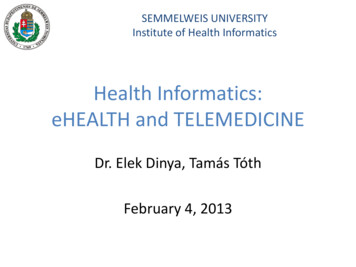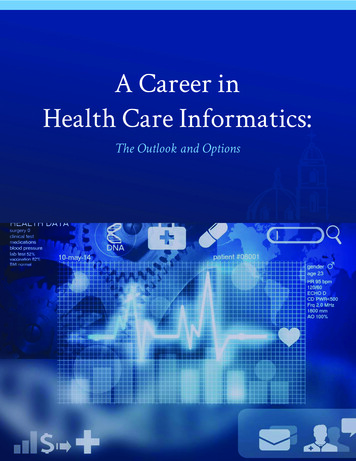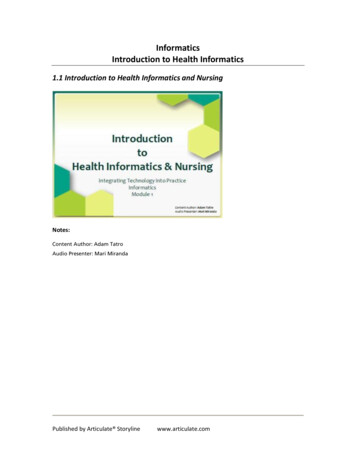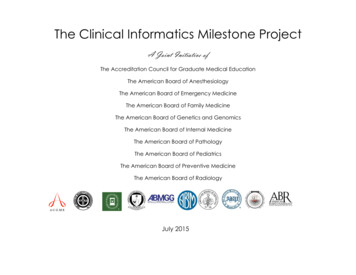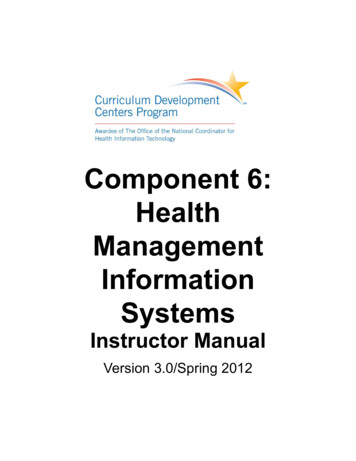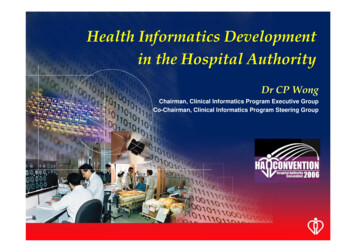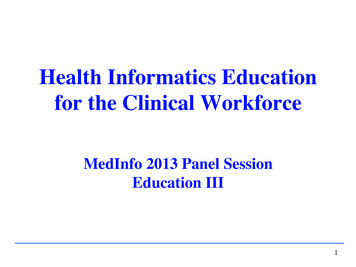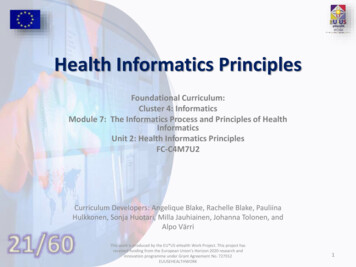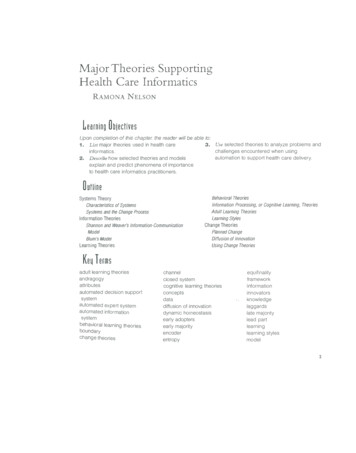
Transcription
MajorTheories SupportingHealth Care InformaticsRAMONA NELSONLearning O biecnvesUpon completion of this chapter the reader will be able to:3. Use selected theories to analyze problems aridList major theories used in health care1.2.informatics.Describe how selected theories and modelsexplain and predict phenomena of importanceto health care informatics practitioners.challenges encountered when usingautomation to support health care delivery.OutlineBehavioral TheoriesInformation Processing, or Cognitive Learning, TheoriesAdult Learning TheoriesLearning StylesSystems TheoryCharacteristics of SystemsSystems and the Change ProcessInformation TheoriesShannon and Weaver's Information-CommunicationModelBlum's ModelLearning TheoriesChange TheoriesPlanned ChangeDiffusion of InnovationUsing Change TheoriesKeq Termsadult learning theoriesandragogyattributesautomated decision supportsystemautomated expert systemautomated informationsystembehavioral learning theoriesboundarychange theorieschannelclosed systemcognitive learning theoriesconceptsdatadiffusion of innovationdynamic homeostasisearly adoptersearly mationinnovatorsknowledgelaggardslate majontylead partlearninglearning stylesmodel3
Keq lerms-cont'dnegentropynoiseopen systemphenomenonreceiverOi Web emsupersystemsystemtarget systemtheoretical modeltheorywisdomGo to the Web site at www.mosbycom/MERLIN/Englebardt/. Here you will find Web links and activitiesrelated to major theories supporting health care informatics.theory explains the process by which cer A tain phenomena occur (Hawking, 1988). Itbegins with an observation of the specificphenomena. An example of a phenomenon isthat people frequently resist change. But whyand how does this phenomenon occur? A theoryrelated to this phenomenon would explain whypeople resist change and predict when and howthey will demonstrate resistance.The following is the four-stage process bywhich most theories develop:A specific phenomenon is noted orobserved.An idea is proposed explaining the de velopment of the phenomenon.3 A model is developed co explain theoperation of the phenomenon. Con cepts key to explaining the phenome non are identified, and the processesby which the concepts interact aredescribed.""· The model is tested, and as support ing evidence accumulates, a theorydevelops.There is no single set of consistent criteria thatcan be applied to decide when a model becomesa theory. As a result, the terms are often used in terchangeably. In ocher words, it is possible forone reference to refer co a phenomenon as a the ory and for another reference to refer co the samephenomenon as a model. For example, one ref erence may refer to a communication theory andanother reference may refer to a communicationmodel, yet both references may be describing thesame phenomenon. In addition, a theoreticalmodei is often used to explain a theory. A theo retical model is a description or figure used tohelp visualize a theory. It includes the conceptsand interactions among the concepts operatingwithin the theory.The building blocks of a theory are calledconcepts. Concepts may be abstract, such aslove, or concrete, such as fruit. Concepts providestructure to a theory. For example, in Figure 1-1the relationship among four concepts is depicted.These four concepts and the location of the con cepts in the figure demonstrate the structure ofthe theory. The interactions among the conceptsin a theory explain the function or operations of
Major Theories Supporting Health Care InformaticsAGUREl-1IOpen System InteractingWith the EnvironmentEnvironmentInput: odn, ---- Itenergy)Pro cessl. . .'· n ou o-HOUo 'uto(.n, ufto mation,ma ter, an dtenergy)Feedbackthat theory. For example, the electrical system ofthe heart is a concrete concept. Impulses travelthrough this system and produce a contractionof the atria and ventricles. The concept of theheart's electrical system and the description ofhow it functions provide a theory that can beused to explain how the heart beats.Because a theory explains the what and howof a phenomenon, it can provide direction forplanning interventions. Continuing the cardiacexample, the cardiac impulse normally beg.ins inthe sinoacrial (SA) node in the right atrium andtravels across the atrioventricular (AV) node tothe ventricles. In atrial fibrillation chis normalprocess is disrupted, and impulses arise at a rapidrace from multiple sites in the atrial muscle. Thiscan result in a fast ventricular response, or tachy cardia. Drugs that block or slow the rate of im pulse transmission at the AV node can be used totreat tachycardia caused by atrial fibrillation.This is an example of using a theory to under stand and manage a problem.\ Health care informatics, as an applied field ofstudy, incorporates theories from informationscience, computer science, and cognitive science,as well as from the wide range of sciences used inthe delivery of health care. As a result, healthcare informatics specialists draw on a wide rangeof theories to guide their practice. This chapterf ; ses on selected theories from a variety of dis ciplines that are of major importance to healthCHAPTER l Scare informatics. These theories are key to un derstanding and managing the challenges facedby health care informatics specialists. In analvz ing the selected theories, the reader will discoverthat understanding these theories presents certainchallenges. Some of the theories overlap, differ ent theories are used to explain the same phe nomena, and sometimes different theories havethe same name. All of these challenges can befound in the theories of information (see the In formation Theories section).The one theory underlying all of the theoriesused in health care informatics is systems theory.Therefore chis is the first theory co be discussedin chis chapter.SYSTEMS THEORYA system is a set of related interacting parts en closed in a boundary ( Von Bertalanffy, 1975\.Examples of systems include computer systems,school systems, the health care system, and a per son. Systems may be living or nonliving. For ex ample, a person is a living system, whereas acomputer is a nonliving system (Joos, Nelson. &Lyness, 1985).Systems may be either open or closed. Closedsystems are enclosed in an impermeable boundaryand do not interact with the environment. An ex ample of a closed system is a chemical reaction en closed in a glass structure with no interaction withthe environment outside the glass. Open systemsare enclosed in semipermeable boundaries and dointeract with the environment. This chapter fo cuses on open systems. Open systems can be usedco understand technology and the people who in teract with the technology. Figure 1-1 demon strates an open system interacting wich the envi ronment. As shown in Figure 1-1, open systemstake input {information/matter/energy) from theenvironment, process the input, and then returnoutput to the environment. The output then be comes feedback to the system. Concepts from sys tems theory can be applied in understanding theway people work with computers in a health care
6 PR RT ONE Foundations of Health Care Informaticsorganization. These concepts can also be used toanalyze individual elements, such as software, orthe total picture of what happens when systemsinteract.A common expression in computer science is"garbage in, garbage out,'' or "GIGO." GIGOrefers to the input-output process. The counter concept implied from this expression is that qual ity input is required to achieve quality output. Al though this expression usually is used whenreferring to computer systems, it can apply to anyopen system. Some examples include the role of apoor diet in the development of health problemsor the role of informed, active participants in se lecting a health care information system. In theseexamples "garbage in" can result in "garbageout," or quality data can support quality output.Not only is quality input required for quality out put, but also the system must have effective pro cedures in place for processing these data. Sys tems theory provides a framework for looking atthe input into a system, for analyzing how thesystem processes that input, and for measuringand evaluating the output from the system.Characteristics of SystemsOpen systems have three types of characteristics:I purpose, functions, and structure. The purpose isthe reason for the system's existence. The purposeof an institution or program is often stated in themission statement. For example, the purpose ofa bachelor of science in nursing (BSN) educa tional program is to prepare professional nurses.Often computer systems arc referred co or classi fied by their purpose. The purpose of a radiologysystem is to support the radiology department;the purpose of a laboratory system is to supportthe laboratory department. A scheduling systemis used to schedule either clients or staff.PurposeIt is possible for a system co have more than onepurpose. For example, a family system or a hos pital information system may have several dif-ferent purposes. One of the purposes of a hospi tal information system is to provide interdepart mental communication. Another purpose is tomaintain a census that can be used to bill pa tients for services rendered.One of the first steps in selecting a computersystem in a health care organization is to iden tify the purpose(s) for that system. There may bea tendency to minimize this step on che basis ofthe assumption that everyone already agrees onthe purpose of the system. Taking the time tospecify the purpose helps to ensure that the rep resentatives from the clinical, administrative, andtechnology domains agree on the reasons for se lecting a system and understand the scope of theproject. Purpose answers the question, "Why se lect a system?"FunctionsFunctions, on the other hand, focus on the ques tion, "How will the system achieve its purpose?"Functions are sometimes mistaken for purpose.However, it is important to clarify why a systemis needed and then to identify what functions thesystem will carry out. Functions are activitiesthat a system carries out to achieve its purpose.For example, a hospital information system mayachieve the interdepartmental communicationpurpose by maintaining an eMail program, aswell as a program for order entry and results re porting. Each time an order is entered into thesystem, it is communicated to the appropriatedepartment. Each time a department has resultsto report, they are communicated back to theclinical unit or appropriate health care provider.When a computer system is being selected, thefunctions are carefully identified and defined inwriting. These are listed as functional specifica tions. Functional specifications identify eachfunction and describe how that function will beperformed.StructureSystems are structured in ways that allow themto perform their functions. Structure follows
Major Theories Supporting Health Care Informaticsfunction. Note how health care teams are orga nized. The organizational structure varies withthe purpose of the organization and the func tions that are co be performed. The organizationof a nursing staff on a clinical unit demonstratesthis concept. They may be organized using theconcept of team nursing, primary nursing, orcase management. In each case the purpose is toprovide patient care. The staff is structured toensure that the functions necessary for nursingcare are completed.Structure Conceptualization Two differentmodels can be used to conceptualize the struc ture of a system. These are hierarchical and web.Both models are in operation at the same time.The first model discussed is the hierarchicalmodel. Figure 1-2 demonstrates this model. lnthis figure each computer is part of a local areanetwork (LAN). The LA,.'\.!s join together to forma wide area network (WAt"i) that is connected tothe mainframe computer. The mainframe is thelead computer, or lead part.In an analysis of the hierarchical model, theterm system may refer to any level of the struc ture. In Figure 1-2 an individual computer maybe referred co as a system,or the whole diagrammay be considered a system. Three terms areused to indicate the level of reference. These aresubsystem, target system, and supersystem. Asubsystem is any system within the target system.For example,if the target system is an LAN, eachcomputer is a subsystem. The supersystem is theoverall structure in which the target system ex ists. If the target system is an LAN,then Figure1-2 represents a supersystem.The second model for analyzing the structureof a system is the web model. The interrelation ships among the different LANs function like aweb. Laboratory data may be sent to the phar macy, and at the same time the clinical unit datacollected by nursing,such as weight and height,may be senc to each department needing these?ata. The web model can also be applied to liv mg systems. Note the processes whereby variousCH R PTER 1 7body systems interact with each other. In healthcare informatics much of the work is accom plished in task groups corresponding to bodysystems. Although someone is in charge of thetask group,the relationships and communicationamong the members of the group flow in a webpattern. As these examples demonstrate, a sys tem includes structural elements from both theweb and the hierarchical model.Structure Characterization Boundary, attri butes, and environment are three concepts usedto characterize structure. The boundary of a sys tem forms the demarcation between the targetsystem and the environment of the system. In put flows into the system by moving across theboundary, and output flows into the environ ment across this boundary. Understandingboundary concepts assists in the development ofhealth care information systems. For example,one of the techniques used in developing healthcare information systems is to divide the healthcare delivery system into modules or subsys tems. This process helps to establish the bound aries of a project. In Figure 1-2 each LAN is .1target system. Each computer in the diagramrepresents a subsystem that can be automated.For example, a health care institution may beplanning for a new pharmacy information sys tem. The new pharmacy system becomes the tar get system. However, the pharmacy system in teracts with other subsystems within the totalsystem. As the task group goes about the workof selecting the new pharmacy system, it willneed to identify the functional specificationsneeded to automate the pharmacy and the functional specifications needed for the pharmacysystem to interact with the other systems in theenvironment. Clearly specifying the target sys tem and the other systems in the environmentwill assist in defining the scope of the project. Bydefining the scope of the project,it becomes pos sible to focus on the task at hand while planningfor the integration of this computer system withother systems in the institution.
8 PRAT OIIE Foundations of Health Care InformaticsAGURE 1-2j Hierarchical Information System '0'00::::: . . :::::BillingMainframe(JRFE.ffiii,\MedicineManaged careAdministrative LANLab---10LUnit 6-EUnit4-EClinical units LANPharmacyCardiologyDepartmental LAN
Major Theories Supporting Health Care InformaticsWhen health care information systems are be ing planned, attributes of the system must beidentified. Attributes are the properties of theparts or components of the system. They are theterms used to describe a system. For example,the attributes of a person include hair color,weight, and intelligence quotient (IQ). Computerhardware attributes are usually referred to asspecifications. An excellent example of a list ofattributes or specifications can be seen in adver tisements or the owner's manual for computerhardware. These include such things as theamount of random access memory (RAM),the size of the hard drive, and even the size of thecase covering the computer. Another example ofa list of attributes can be seen on an intake or pa tient assessment form for a health care setting.The form lists the attributes of interest. A com pleted form describes the individual patient's ex pression of these attributes.Attributes and the expression of those attri butes play a major role in the development ofdatabases. Field names are a list of the attributesof interest for a specific system. The datum ineach cell is the individual system's expression ofthat attribute. A record lists the attributes foreach individual system. The record can also beseen as a subsystem of the total database system.A complete discussion of databases can be foundin Chapter 3.Systems and the Change ProcessBoth living and nonliving systems are constantlyin a process of change. Six concepts are helpfulin understanding the change process. These aredynamic homeostasis, entropy, negentropy, spe cialization, reverberation, and equifinality. Dy namic homeostasis refers to the processes usedby a system to maintain a steady state or bal ance. An excellent example is the fluctuationsseen in normal body chemistry. Blood levels ofnormal blood elements begin the drift down orup. Through a feedback loop the body begins coproduce more of the decreasing elements andCHAPTER 1eliminate the excess elements. As the blood levelchanges, the feedback loop kicks in to reverse theprocess.Chapter 10 discusses the life cycle of an infor mation system. One of the stages in this life cycleis maintenance. .Maintenance includes a numberof activities that function to keep the system op erating. Organizations that experience rapid orextensive change experience increased stress be cause the dynamic homeostasis of the organiza tion is challenged. People working within chang ing organizations will attempt to maintain asteady state. The result can be seen as resistanceto change. An informatics example is the intro duction of automation or the introduction of anew computer system that stresses the dynamichomeostasis of the organization. Managingchange and thereby decreasing the stress experi enced by individual users, as well as the stress ex perienced by the organization as a whole, is amajor piece of the work accomplished by thehealth care informatics specialist.Entropy is the tendency of all systems tobreak down into their simplest parts. As theybreak down, the systems becomes increasinglydisorganized or random. In data transmission,entropy measures the loss of information whena signal is transmitted. Entropy is demonstratedin the tendency of all systems co wear out. It isthe tendency of all living systems to reach thepoint of death. Even with maintenance, a healthcare information system will reach a point whereit must be replaced.Negentropy is the opposite of entropy. This 1sthe tendency of living systems to grow and be come more complex. This is demonstrated in thegrowth and development of an infant, as well asin the increased size and complexity of today'shealth care system. With the increased growthand complexity of the health care system therehas been an increase in the size and complexityof health care information systems.As systems grow and become more complex,they divide into subsystems and then subsubsys tems. This is the process of differentiation and9
lO PART ONE Foundations of Health Care Informaticsspecialization. Note how the human body beginsas a single cell and chen differentiates into differ ent body systems, each wich specialized pur poses, strucrnres, and functions. This sameprocess occurs with health care delivery systems,as well as with health care information systems.As chis process occurs, a lead part emerges. Thelead part is at che top of the hierarchy. Lead paresplay primary roles in organizing and maintain ing vertical and horizontal data/informationflow. Changes to the lead part can have a majorimpact a .:ross the total system. For example, ifthe chief information officer leaves che organiza tion, the impact is much more significant than ifa beginning-level systems analyst moves to an other organization. If the mainframe in Figure1-2 were to stop functioning, the impact wouldbe much more significant than if an individualcomputer on one of che LANs were co stop func tioning. Understanding the role of the lead partcan be key co developing the security and disas ter plan for a health care information system.Change within any part of the system will bereflected across the coral system. This is referredto as reverberation. Reverberation is reflected inthe intended and unintended consequences of sys tem change. When planning for a new health careinformation system, the team will attempt to iden tify the intended consequences or expected bene fits co be achieved. Although it is often impossibleto identify a comprehensive list of unintendedconsequences, it is important for rhe team to con sider che reality of unintended consequences. Thepotential for unintended consequences should bediscussed during the planning stage; however,these consequences will be more evident duringthe testing stage chat precedes implementation, or"go live." Often, unintended consequences arcnot considered until after go live, when they be come obvious. For example, eMail may be suc cessfully introduced to improve communicationin an organization. However an unintended con sequence can be an increased workload resultingfrom irrelevant eMail messages.Equi.finality refers to the ability of open sys tems to reach the same end state by starting atdifferent initial states and by using differentmeans. For example, several hospitals may beimplementing new hospital information systems.The staff in che various hospitals may or may notbe experienced in using chis type of software.The hospitals may select from several differentapproaches for training the staff. Some may useclinical staff and develop superusers. Others mayhire outside consultants to do all the training.Ochers may use information technology or staffdevelopment personnel co do the training. Nomatter what the initial knowledge level of thepersonnel or the training approach used, each ofthese hospitals has the potential to effectivelytrain staff and experience a successful imple mentation. In other words, there is no one cor rect way to manage many of the challenges in herent in health care informatics.All systems change and in the process interactwith the environment. This interaction is shownin Figure 1-1. Input into the system consists of en ergy, information, and matter. This input is thenprocessed and results in output. Understandingthis process as it applies to informatics involvesan understanding of information theories.INFORMATION THEORIESThe term information has several different mean ings (Information, 2000). An example of this canbe seen in Box 1-1. Juse as the term informationhas more than one meaning, the term informa tion theory refers to more than one theory. Thischapter examines two theoretical models of in formation theories: Shannon and Weaver's infor mation-communication model and Blum's model.Shannon and Weaver'sInformation-Communication ModelInformation theory as a formal theory was bornin 1948 with the publication by Claude Shannonof the landmark paper "A Mathematical Theoryof Communication" (Shannon, 1948).The concepts in this model are presented inFigure 1-3. The sender is the originator of the
Major Theories Supporting Health Care InformaticsCHAPTER 1 11. AGUHE f: I Information-Communication ModelI"""""4l:I -f-----,MIEoooci,.-a c- : ne l o e c o de - - , NoiseDefinitions of Informationin·for-ma·tionnounPronunciation: "in-f&r-'mA-sh&n1. The communication or reception of knowl edge or intelligence2. a. Knowledge obtained from investigation,study, or instructionb. The attribute inherent in and communi cated by one of two or more alternativesequences or arrangements of some thing (as nucleotides in DNA or binarydigits in a computer program) that pro duce specific effectsc. (1) A signal or character (as ma com munication system or computer) repre senting data (2) Somethmg (as a mes sage, experimental data, or a picture)message. The encoder converts the content of themessage to a code. The code can be letters,words, music, symbols, or a computer code. Forexample, the modem on a computer acts as anencoder when it converts a file from a digitalform to an analog form so that it can be sentover telephone lines that carry analog soundwaves. The telephone line is the channel. A chan·nel carries the message. Examples of channels in clude sound waves, telephone lines, and paper.Each channel has its own physical limitations int rms of the size of the message that can be ear ned. Noise is anything that is not part of thewhich justifies change in a consuuct (asa plan or theory) that represents physi cal or mental experience or anotherconstructd. A quantitative measure of the contentof information; specifically: a numericalquantity that measures the uncertaintyin the outcome of an experimenc to bepedormed3. The act of informing agamst a person4. A formal accusation of a crime made by aprosecuting officer as distinguished from anindictment presented by a grand juryFrom Information. In Merriam- Webster online:,\,ferriam- Webster's collegiate dictionary. ( 2000). Re·trieved October 8, 2000, from the World Wide Web:http://www.m-w.com/dict1onary.htm.message but occupies space on the channel and istransmitted with the message. Some examples ofnoise include static on a telephone line and background sounds in a room. The decoder convertsthe message co a format that can be understoodby the receiver. When one is listening co a phonecall, the telephone is a decoder. It converts theanalog signal back into sound waves, which areunderstood as words by the person listening. Theperson listening to the words is the receiver.Shannon, one of the authors of the Shannonand Weaver information-communication theory.was a telephone engineer. He was not concerned
12 PART ONE Foundations of Health Care Informaticswith the semantic meaning of the message butrather with the technica.1 problems involved insignal transmission across a communicationchannel or telephone line. He used the conceptof entropy to explain and measure the amountof information in a message. The amount of in formation in a message is measured by the ex tent that the message decreases entropy. The unitof measurement is a bit. A bit is represented by a0 (zero) or a 1 (one). The two sides of a coin canbe used to explain this concept. If a coin isthrown into the air, it may land on either of twopossible sides: heads up or tails up. This can becoded as 1 for heads up and O for tails up. Usingthis approach, the message concerning whichside is up is transmitted with 1 bit. If there werefour possible states, additional bits would beneeded to transmit the message. For example, ifthe message could be north, south, east, or west,it might be coded 00 for north, 11 for south, 01for east, or 10 for west. Computer codes arebuilt on this concept. For example, how manybits are needed to code the letters of the alpha bet? What other symbols are used in communi cation and must be included when developing acode?Warren Weaver, from the Sloan-Kettering In stitute for Cancer Research, provided the inter pretation for understanding the semantic mean ing of a message (Shannon & Weaver, 1949). Heused Shannon's work to explain the interper sonal aspects of communication. For example, ifthe speaker is a physician who uses medicalterms that are not known to the receiver (the pa tient), there will be a communication problemca used by the method used to encode the mes sage. However, if the patient cannot hear well,he or she may not hear all of the words in themessage. In this case the communication prob lem is caused by the patient's ear, which is havingdifficulty converting the sound waves into neu rological impulses that the brain can decode.The communication-information model pro vides an excellent framework for analyzing theeffectiveness and efficiency of information trans-fer and communication. For example, a physicianmay use a computerized order entry system to en ter orders. Several questions illustrate the infor mation transfer process. Is the order entry screendesigned to capture and code all of the key ele ments for each order? Are all aspects of the mes sage coded in a way that can be transmitted anddecoded by the receiving computer? Does themessage that is received by the receiving depart ment include all of the key elements in the mes sage sent? Does the screen design at the receiver'send make it possible for the message to be de coded or understood by the receiver?These questions demonstrate three levels ofcommunication that can be used in analyzingcommunication problems (Hersh, 1996). Thefirst level of communication is the technical Ilevel. Do the system's hardware and softwarefunction effectively and efficiently? The secondlevel of communication is the semantic level. ./Does the message convey meaning? Does the re ceiver understand the message that was sent bythe sender? The third level of communication isthe effectiveness level. Does the message produce {the intended result at the receiver's end? For ex ample, did the physician order one medicationbut the patient received a different medicationwith a similar spelling? Some of these questionsrequire a more in-depth look at how health careinformation is produced, transferred, and used.Bruce Blum's definition provides a frameworkfor this more in-depth analysis.Blum's ModelBruce L. Blum developed a definition of infor-1mation from an analysis of the accomplishmentsin medical computing. In his analysis Blum iden tified three types of health care computing appli cations. He grouped applications according tothe objects that they processed: data, informa tion, or knowledge. He defined data as uninter preted elements, such a
the delivery of health care. As a result, health care informatics specialists draw on a wide range of theories to guide their practice. This chapter f ; ses on selected theories from a variety of dis ciplines that are of major importance to health care informatics. These theories are
